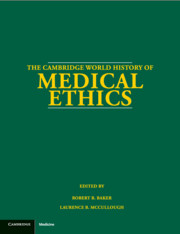Book contents
- Frontmatter
- PART I AN INTRODUCTION TO THE HISTORY OF MEDICAL ETHICS
- PART II A CHRONOLOGY OF MEDICAL ETHICS
- PART III DISCOURSES OF MEDICAL ETHICS THROUGH THE LIFE CYCLE
- 3 Medical Ethics through the Life Cycle in Hindu India
- 4 Medical Ethics through the Life Cycle in Buddhist India
- 5 Medical Ethics through the Life Cycle in China
- 6 Medical Ethics through the Life Cycle in Japan
- 7 Medical Ethics through the Life Cycle in Europe and the Americas
- 8 Medical Ethics through the Life Cycle in the Islamic Middle east
- PART IV THE DISCOURSES OF RELIGION ON MEDICAL ETHICS
- PART V THE DISCOURSES OF PHILOSOPHY ON MEDICAL ETHICS
- PART VI THE DISCOURSES OF PRACTITIONERS ON MEDICAL ETHICS
- PART VII THE DISCOURSES OF BIOETHICS
- PART VIII DISCOURSES ON MEDICAL ETHICS AND SOCIETY
- Appendix: Biographies: Who Was Who in the History of Medical Ethics
- Bibliography
- Index
3 - Medical Ethics through the Life Cycle in Hindu India
from PART III - DISCOURSES OF MEDICAL ETHICS THROUGH THE LIFE CYCLE
Published online by Cambridge University Press: 28 May 2012
- Frontmatter
- PART I AN INTRODUCTION TO THE HISTORY OF MEDICAL ETHICS
- PART II A CHRONOLOGY OF MEDICAL ETHICS
- PART III DISCOURSES OF MEDICAL ETHICS THROUGH THE LIFE CYCLE
- 3 Medical Ethics through the Life Cycle in Hindu India
- 4 Medical Ethics through the Life Cycle in Buddhist India
- 5 Medical Ethics through the Life Cycle in China
- 6 Medical Ethics through the Life Cycle in Japan
- 7 Medical Ethics through the Life Cycle in Europe and the Americas
- 8 Medical Ethics through the Life Cycle in the Islamic Middle east
- PART IV THE DISCOURSES OF RELIGION ON MEDICAL ETHICS
- PART V THE DISCOURSES OF PHILOSOPHY ON MEDICAL ETHICS
- PART VI THE DISCOURSES OF PRACTITIONERS ON MEDICAL ETHICS
- PART VII THE DISCOURSES OF BIOETHICS
- PART VIII DISCOURSES ON MEDICAL ETHICS AND SOCIETY
- Appendix: Biographies: Who Was Who in the History of Medical Ethics
- Bibliography
- Index
Summary
INTRODUCTION
All human lives go through physical changes from birth to death. This is the biological base line of the life cycle. How these changes are defined and marked as stages, however, has been religiously based in most societies. Birth and death, in turn, frame the life cycle and pose the fundamental religious questions of human meaning and destiny. Because the life cycle is intertwined with the reproductive and intergenerational cycles, on which species and group survival are based, religions have used their highest authority to complement biology with culture to create order in the form of norms. Because human life has its phases and moments of vulnerability (birth, illness, old age, and dying), religions have also used their authority to protect the vulnerable through an ethics of care, if not inviolable sanctity ascribed to life itself.
STAGES AND RITUAL MARKINGS OF THE LIFE CYCLE
There are different views on the number of stages in the Hindu life cycle (Tilak 1989, 70–71), some late accounts numbering forty (an indication of the extensive ritualism of the religion). For the three upper castes (brāhmaṇas, kṣatriyas, and vaiśyas) stages are marked by rituals called saṃskāras, performed by brāhmaṇas (Brahmin priests). One set of rituals exists at the beginning of life (conception to early childhood). This cluster can be attributed to the religion's family orientation, its recognition that conception and a stable pregnancy resulting in birth are never guaranteed, and its awareness that pregnancy, infancy, and early childhood are times of great vulnerability.
- Type
- Chapter
- Information
- The Cambridge World History of Medical Ethics , pp. 99 - 112Publisher: Cambridge University PressPrint publication year: 2008



